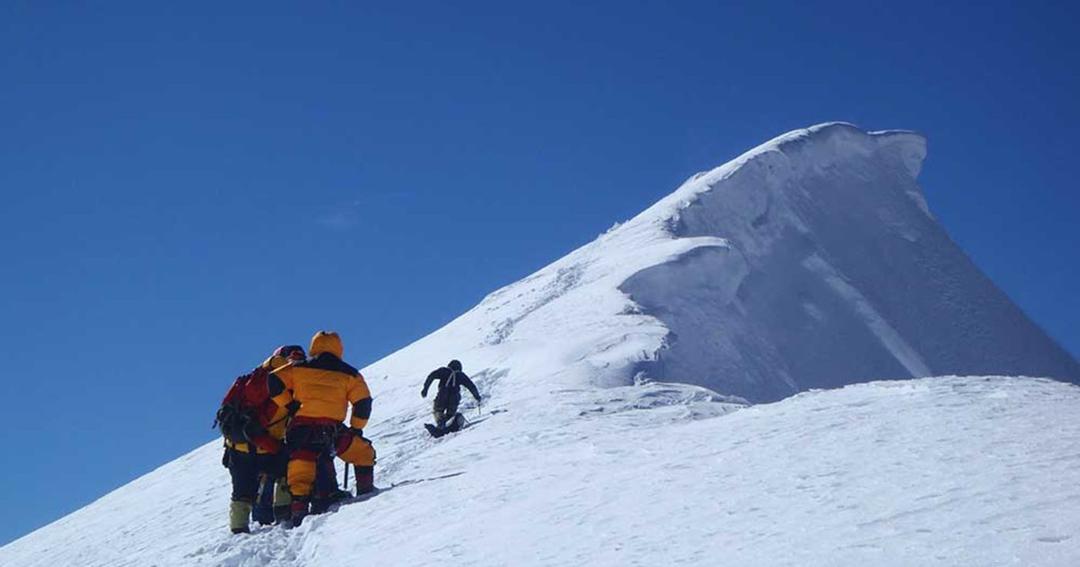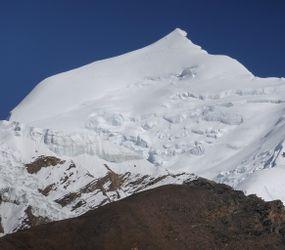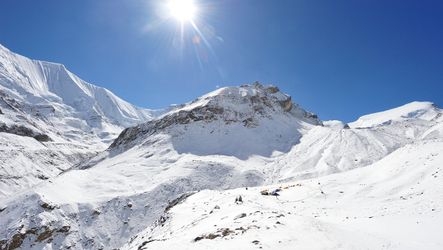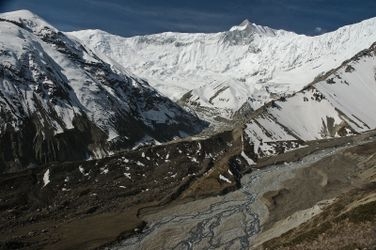Climbing Himlung Himal





Himlung Himal, located in the Nepal section of the Himalayas, stands tall at an impressive 7,126 meters. This peak, though less frequented than its famed neighbors like Annapurna or Manaslu, offers a unique and rewarding climb for those seeking a less commercialized adventure. The ascent is mostly non-technical, but don't let that fool you into thinking it's a walk in the park. The climb demands respect, given its altitude and the potential for unpredictable weather conditions. Seasoned climbers will appreciate the relatively untouched nature of the route, which provides a sense of solitude and connection to the raw beauty of the mountains.
Most expeditions to Himlung Himal begin at the village of Phu, following a scenic trek that serves as a perfect acclimatization period. The approach is a harmonious blend of cultural immersion and wilderness trekking, setting the stage for the challenges ahead. The mountain itself offers a series of camps before the final push to the summit, which is usually attempted from Camp 3. Expect long days on the ice and snow, with crevasse navigation and steep slopes that test your stamina and resolve. The rewards are equally great, with panoramic views at the summit that few have had the privilege to witness.
Climbing Himlung Himal is a commitment that requires careful planning and a willingness to embrace the unknown. The conditions can range from straightforward ice and snow ascents to more challenging mixed terrain, depending on the season and weather patterns. It's an ideal expedition for experienced climbers looking to push their limits in a less crowded environment. While the mountain is gaining popularity, it still retains an air of exclusivity. There are currently 46 guides offering expeditions to this remarkable peak, providing ample opportunity for those ready to undertake this adventure.
Table of contents
Route
- 4,526 m gain over 28 days
- Starting and ending in Besisahar / Koto
- approach: drive, walk in
Walk in
- +2,300 m over a 35 km approach
- 6 - 7 days in
- 3 - 4 days out
Climb
- +2,276 m over 9 - 11 days.
- 3 high camps. Camp 3 is optional
Difficulty
- AD: Fairly hard (alpine grade 3)
When to go
- April and May
- October
Permits
- 3 permits are needed
- costing around $1395 total
Guide mandatory?
- no
These are pictures taken while climbing Himlung Himal. They're shown here to give you an idea of what the route is like. You're welcome to share your own pictures of climbing Himlung Himal, to help the community of climbers. Picture here are either uploaded by members (their own, or creative commons pictures), or guides.
Guide links
Himlung Himal History
Climbing history of Himlung Himal
The history of Himlung Himal is marked by a series of early summit attempts that paved the way for future climbers. The mountain, nestled in the remote region bordering Nepal and Tibet, remained relatively unexplored until the late 20th century. It wasn't until 1992 that a Japanese expedition successfully reached the summit, marking the first known ascent of Himlung Himal.
The area surrounding Himlung Himal is inhabited by the indigenous people of the Nar-Phu Valley, a unique ethnic group with a rich cultural heritage. Their traditional lifestyle and customs have remained largely unchanged for centuries, offering a glimpse into a way of life that has persisted despite the challenges of the high-altitude environment. These local communities play an essential role in supporting climbing expeditions, sharing their invaluable knowledge of the terrain and weather conditions.
 Base Camp
Base Camp
 Camp 1
Camp 1
 Camp 2
Camp 2
 Camp 3
Camp 3
 Summit
Summit
Himlung Himal weather
How is the weather on Himlung Himal, and when is the best time to go.
The best time to climb Himlung Himal is in these months:
- Apr
- May
- Oct
Himlung Himal Gear Packing List
What To Take to climb Himlung Himal
- Clothing:
- Insulated jacket
- Waterproof jacket
- Down or synthetic sleeping bag
- Base layers (thermal tops and bottoms)
- Hiking pants
- Fleece or softshell jacket
- Gloves (inner and outer)
- Warm hat
- Sun hat or cap
- Gaiters
- Hiking socks
- Mountaineering boots
- Camp shoes or sandals
- Equipment:
- Mountaineering backpack
- Sleeping pad
- Trekking poles
- Climbing harness
- Crampons
- Ice axe
- Helmet
- Climbing rope
- Carabiners
- Prusik cords
- Rappel device
- Headlamp with spare batteries
- Sunglasses with UV protection
- Water bottles or hydration system
- Water purification tablets or filter
- First aid kit
- Map and compass
- Sunscreen and lip balm
- Toiletries
- Trekking towel
- Food and Nutrition:
- High-energy snacks
- Dehydrated meals
- Energy gels or bars
- Electrolyte powder
- Miscellaneous:
- Camera with spare batteries
- Portable charger
- Multi-tool or knife
- Repair kit (for clothing and equipment)
- Duct tape
- Ziplock bags (for waterproofing)
- Cash and identification
- Travel insurance documents
- Permits and necessary paperwork
- Emergency contact information
Himlung Himal Services
Gear rental, porters, guides, transport, internet, accommodation
Accommodation
Accommodation options along the Himlung Himal route primarily consist of basic tea houses and tented camps. Tea houses provide simple lodging with shared facilities, while trekkers may also need to carry their own camping gear for some sections of the route.Food
Food is available along the Himlung Himal route, but the options may be limited. Tea houses and trekking agencies offer meals such as local Nepali dishes and some international cuisine. It is advisable to carry some high-energy snacks and consider dietary preferences and requirements in advance.Guides
Experienced guides are available for the Himlung Himal route and are highly recommended, especially for climbers with limited mountaineering experience. Guide fees can vary depending on the duration and level of support required. It's crucial to select a qualified and licensed guide who can provide necessary assistance, navigation, and safety expertise.Porters
Porters are available to assist with carrying heavy equipment and supplies during the climb. Hiring porters helps alleviate the burden of carrying a heavy load and allows climbers to focus on the ascent. Porters' fees are typically based on the weight of the load and the duration of the trek.Medical facilities
Limited medical services are available along the Himlung Himal route. Basic first aid and medical facilities can be found at tea houses or base camps, but it is important to carry a personal first aid kit. It is recommended to have travel insurance that covers emergency evacuation in case of any medical emergencies.Gear rental
While some gear can be rented in Kathmandu or nearby towns, climbers are generally expected to bring their own personal climbing equipment, including mountaineering boots, crampons, ice axes, harnesses, and other essential gear. It is crucial to have appropriate gear for the challenging terrain and cold weather conditions.Transport
To reach the Himlung Himal route, a combination of domestic flights, bus or jeep rides, and trekking is typically involved. The starting point for the route is usually reached by flying to Besisahar and then driving to Koto. Optional helicopter services may be available for a more direct and convenient access.Internet / Phone
Connectivity along the Himlung Himal route is limited. Mobile phone coverage may be available at certain points, but it can be unreliable and sporadic. Internet access and Wi-Fi are scarce. It is advisable to inform your loved ones about the limited communication options and consider alternative means of communication or emergency devices.ATMs
There are no ATMs available along the Himlung Himal route. It is recommended to carry enough cash for the entire duration of the trek, including additional funds for unforeseen circumstances.Shops
There are limited shops along the route, primarily at tea houses or small settlements. These shops offer basic supplies such as snacks, bottled water, toiletries, batteries, and some trekking gear. However, the availability of items may be inconsistent, so it is advisable to carry essential supplies and equipment beforehand.Himlung Himal permits
What permits are needed for climbing Himlung Himal
1. Restricted Area Permit (RAP)
- $18 (~2,000 in the local currency)
- Allows entry into the restricted areas along the Himlung Himal route.
- The RAP can be obtained through a registered trekking agency in Nepal before starting the climb.
2. Climbing Permit
- $1350 (~150,000 in the local currency)
- Authorizes climbing Himlung Himal and includes necessary support from the local authorities.
- The Climbing Permit must be obtained through a registered trekking agency in Nepal before starting the climb.
3. National Park Entry Permit
- $27 (~3,000 in the local currency)
- Allows entry into the national park where Himlung Himal is located.
- The National Park Entry Permit can be obtained at the entry checkpoint or through a registered trekking agency in Nepal.
Himlung Himal access - getting there
How to get to Himlung Himal
Start walking in from either Koto or Besisahar (for a bit more acclimitization).
- Arrival:
- Fly to Kathmandu, Nepal
- Take an international flight to Tribhuvan International Airport in Kathmandu, the capital city of Nepal.
- Domestic Flight:
- Take a domestic flight to Besisahar
- From Kathmandu, take a domestic flight to Besisahar, a town in the Lamjung District. This flight saves time and provides a convenient access point for the Himlung Himal route.
- Overland Travel:
- Drive to Koto via Besisahar
- From Kathmandu, travel by road to Besisahar, and then continue the journey to Koto, the starting point for the Himlung Himal climb. This overland option allows you to experience the scenic beauty of the region.
These are variations on the typical route. Which could be added on; either part way along or at the start / end to extend the trek.
Pisang Peak Climb
add 4 extra days
Himlung Himal questions
What to know about climbing Himlung Himal
Common questions people have about this trek, if yours isn’t here - add it to get an answer.
These climbs are similar in length, difficulty, and elevation. Offering a similar level of challenge as the Himlung Himal climb.




